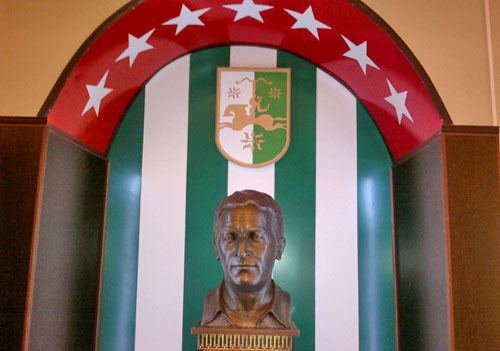50,000 (mostly Georgians) fled the city in the aftermath of the events. The members of Georgian administration of Abkhazia are executed. 10,000 - 30,000 ethnic Georgians are killed in Abkhazia. Probably thousands in Sukhumi. Location Sukhumi | Date 27 September 1993 | |
 | ||
one battalion several thousand combatants Result Ethnic cleansing of the Georgian population Similar War in Abkhazia, 2001 Kodori crisis, Siege of Tkvarcheli, Battle of the Kodori Valley, Battle off the coast of Abkhazia | ||
The Sukhumi massacre took place on September 27, 1993, during and after the fall of Sukhumi into separatist hands in the course of the War in Abkhazia. It was perpetrated against Georgian civilians of Sukhumi, mainly by militia forces of Abkhaz separatists, their North Caucasian and Russian allies. It became part of a violent ethnic cleansing campaign carried out by the separatists.
Contents
Events
On September 27, 1993, separatist forces violated the ceasefire initiated by the United Nations and guaranteed by the Russian Federation, which barred both sides from performing military operations. As part of the ceasefire, Georgian forces had withdrawn their heavy artillery and tanks from Sukhumi. Abkhaz, Confederation of Mountain Peoples of the Caucasus, Cossack and Russian militants stormed Sukhumi early in the morning. Confronted by large numbers of combatants, the Georgian army units that remained in the city were unable to prevent the separatist advance into the city. By noon, separatist militants and their allies had taken over television buildings and bridges. Georgian forces retreated to the Government building of the Abkhazian Autonomous Republic, where they intended to provide security for members of Abkhazian Autonomous Republic Government. By late afternoon, the city was overrun by separatists and their allies.
Placing their hopes on the ceasefire, a large number of civilians remained in the city. The separatists and their allies started to sweep through the streets of Sukhumi rounding up all civilians that they found. Men, women and children were executed in the streets, on the roads and inside their own apartments, houses and back yards. According to the witnesses, many people became objects of torture, and some were forced to watch as their own family members were killed—children in front of their parents, and parents in front of their children.
Women became targets of sadistic rape. Refugees recall people being burned to death, disembowelled and dismembered while still alive The massacres occurred in the city park, in front of the governmental building, in schools and hospitals. Almost all members of the Abkhaz government (those who refused to leave the city), Zhiuli Shartava, Guram Gabiskiria, Mamia Alasania, and Raul Eshba were captured and executed.
The 1994 U.S. State Department Country Reports also describes scenes of massive human rights abuse:
"The [Abkhaz] separatist forces committed widespread atrocities against the Georgian civilian population, killing many women, children, and elderly, capturing some as hostages and torturing others ... they also killed large numbers of Georgian civilians who remained behind in Abkhaz-seized territory...." "The separatists launched a reign of terror against the majority Georgian population, although other nationalities also suffered. Chechens and other north Caucasians from the Russian Federation reportedly joined local Abkhaz troops in the commission of atrocities.... Those fleeing Abkhazia made highly credible claims of atrocities, including the killing of civilians without regard for age or sex. Corpses recovered from Abkhaz-held territory showed signs of extensive torture."(The evidence available to Human Rights Watch supports the U.S. State Department’s findings.)Aftermath
Eduard Shevardnadze fled the city only just before the arrival of separatist forces, having earlier committed to try to remain there as long as possible. Soon the forces overran the whole territory of Abkhazia, except a small region of the Kodori Gorge (which remained under the control of the Georgian warlord Emzar Kvitsiani until July 2006 and later the Tbilisi government until August 2008). The total defeat of the Georgian government forces was followed by ethnic cleansing of Georgian population. 200,000 - 250,000 refugees (mainly Georgians) were forced out of Abkhazia. Violence continued in 1994 despite an agreement between the Georgian and Abkhazian governments for the deployment of a peacekeeping force from the Commonwealth of Independent States. Chechen militants who had fought on the side of Abkhazia later took part in the First Chechen War.
Perpetrators
There are a number of conflicting claims as to whether the massacre was conducted by Abkhaz militias or those of their Russian and North Caucasian allies. Allegedly, the commander of the separatist forces, partly responsible for the massacre was the deputy defence minister and "hero" of Abkhazia Shamil Basaev. According to witness testimonies, the militants spoke North Caucasian languages and Russian. However, some refugees who survived the massacre have claimed that they recognized their Abkhaz and Armenian neighbours collaborating with the militants during the massacres in various neighbourhoods. Many people recall the commands given by Russian officers: "Do not take prisoners alive!"
Houses and land owned by Georgians were ransacked and taken over by the Abkhaz, Russians, Cossacks and other newcomers. These allegations are currently being investigated by the International Criminal Court in the Hague. The Organization for Security and Co-operation in Europe (OSCE) has recently given its recognition to and condemned the ethnic cleansing of Georgians in Abkhazia. Although many separatist militants have been accused of committing massacres none of them have yet been tried.
